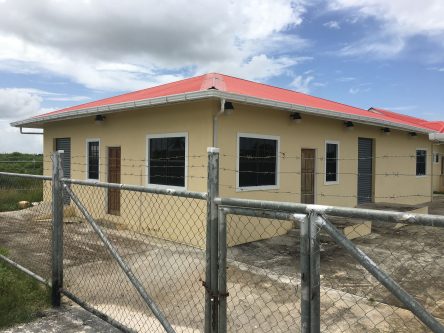While questions have been raised about the viability of the plantain chip factory that has been completed at Leguan, plantain farmers are excited about the venture and say they are willing to invest more in order to be able to provide an adequate supply.
Stabroek News visited the island on Tuesday and spoke with several farmers who currently cultivate plantains on a large scale.
“It will be very interesting and once we get the right price for the plantains, then I think it is going to be a very good investment for the market,” farmer Rohan (only name given) told Stabroek News.
He explained that currently he is planting some 300 suckers of plantain and has the capacity to produce over 1,000 pounds every fortnight. “I feel it is going to be very good, especially with the way how rice is working now then plenty people might decide to go into plantain and banana and what’s not,” Rohan said, while pointing out that the current price for plantain fluctuates from $30 per pound to about $100 per pound.

According to Rohan, most of the plantain that is reaped from the island goes to the Parika market.
The farmers explained that the island is able to produce some 16,000 pounds of plantain per week, which is often exported elsewhere.
“Most of the plantain, if not all, that we does collect from the backdam does go over the river to Parika or somewhere else. I know I does sell to a chip man but he don’t produce anything big. Some other farmers does do the same too but with the factory it would be different,” Rohan said.
Another farmer said he believed that the factory is “going to help a lot” given the volume of plantain currently produced on the island.
“Nah me alone does plant but the whole bottom here. They could get at least 10,000 pounds every fortnight just from here and even more from the island,” the farmer said, while pointing out that even if the island cannot fill the factory’s quota, then other places such Hog Island, Wakenaam and Bonasika can pitch in to meet the demand.
“This morning a man carry at least two boat loads at about 6,000 pounds.
When the chip factory gets started, we are going to invest more,” he said.
He also indicated that the current trend is that rice farmers are converting more of their lands to plantain cultivation since due to issues affecting the rice industry.
In addition, the farmers said that since the factory is located on the island, it would be easier for them to transport their produce.
Currently, they have to move the plantains from the farmlands onto a boat, which then takes the load to Parika, where the price is always fluctuating.
“One time you could get it at about $30 per pound and another time at $100 per pound,” Rohan said.
He added that the farmers are hoping that when the factory starts, there will be a stable price per pound that will be both beneficial to the farmers and the factory itself.
In a letter to Stabroek News in May, writer Charles Sohan had argued that the prospective factory is not feasible.
“Leguan is predominantly a subsistence rice-growing region with some cattle rearing undertaken here and there. It has never produced plantains or bananas in commercial quantities and would be unable to do so in the foreseeable future because of the high cost of crop conversion and infrastructure development particularly field layout and adequate drainage and irrigation for plantain cultivation. Further, the island has no potable water supply, an unreliable electricity supply, a network of poor roads and a rickety stelling.
Therefore, no manufacturing facility for plantain chips can operate successfully unless the necessary infrastructure is in place and raw materials are available in a reliable manner and a competitive price to make the plant fully operational,” he had said.
He added that from all indications no feasibility study was done on the factory since no economic and financial analysis would show that the project is viable and “therefore not worth of any investment.”
The project was started by the previous administration and completed by the APNU+AFC government.




